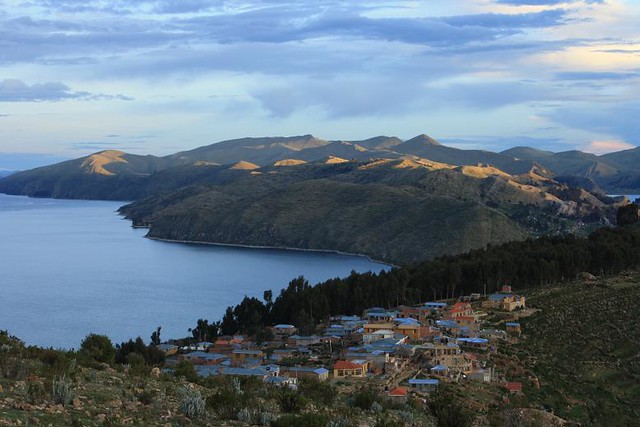
Isla del Sol is an island in the southern part of Lake Titicaca. It is part of the modern Plurinational State of Bolivia. Geographically, the terrain is harsh; it is a rocky, hilly island. There are no motor vehicles or paved roads on the island. The main economic activity of the approximately 800 families on the island is farming, with fishing and tourism augmenting the subsistence economy. Of the several villages, Yumani and Cha'llapampa are the largest.
There are over 80 ruins on the island. Most of these date to the Inca period circa the 15th century AD. Archaeologists have discovered evidence that people lived on the island as far back as the third millennium BCE. Many hills on the island contain agricultural terraces, which adapt steep and rocky terrain to agriculture. Among the ruins on the island are the Sacred Rock, a labyrinth-like building called Chicana, Kasa Pata, and Pilco Kaima. In the religion of the Incas, it was believed that the sun god was born here.
The Aymara name for the island is Titi'kaka. The original meaning of this word is not known. Some linguists and archaeologists believe the name to be a corruption of Titi and Kala . In the 1612 Aymara-Spanish dictionary of Ludovico Bertonio, the phrase Tahksi kala is listed as "piedra fundamental" or "foundation stone" possibly alluding to the origin story of the Inca that the Sun and Moon were born in the lake.
The chronicler Bernabé Cobo documented two versions of an Inca origin myth that took place on the northern part of this island.The first Inca Manco Cápac is said to have emerged from a prominent crag in a large sandstone outcrop known as Titikala (the Sacred Rock). Manco Cápac is the son of Inti the Andean deity identified as the sun. In one version of the myth, the ancient people of the province were without light in the sky for many days and grew frightened of the darkness. Finally, the people saw the Sun emerge from the crag and believed it was the Sun's dwelling place. In another version related by Cobo, others believed the crag was dedicated to the Sun because it hid under the crag during a great Flood. Isla del Sol was the first land that appeared after the flood waters began to recede and the Sun emerged from Titikala to illuminate the sky once again. A temple was built at this rock and later expanded by the 10th Inca Tupac Inca Yupanqui. He built a convent for mamaconas and a tambo for visiting pilgrims.
Excavations at the archaeological site of Ch'uxuqullu, located on a small peak above the Bay of Challa, led to the recovery of Archaic Preceramic remains that radiocarbon dated to about 2200 BC.Eight obsidian flakes were recovered from this context, and Neutron Activation Analysis of three of the flakes revealed that all of them were from the Chivay obsidian source which is located in the Colca Canyon, Department of Arequipa. The presence of Chivay obsidian is clear evidence that inhabitants of the island were participating in a wider network of exchange.
According to one bathymetric model,there is no path between the shore edge and the Island of the Sun that does not pass over areas where the lake bottom reaches a depth of 200 m or greater. Paleoclimate studies indicate that around 3100 BC the level of Lake Titicaca would have been as much as 85 m lower than modern conditions, but that it had reached near modern levels by about 2000 BC.Thus, at 2200 BC lake levels were probably lower than at present. Data from Ch'uxuqullu could suggest that lake shore cultures were using well-developed watercraft technology during the Archaic period.
Underwater archaeological investigations conducted off the Island of the Sun from 1989-92 led to the discovery of both Inca and Tiahuanaco artifacts. These are now on display at a site museum in Challapampa.Today the economy of the island is mainly driven by tourism revenues, but subsistence agriculture and fishing are widely practiced.


COPACABANA


En la Comunidad Yumani de la Isla del Sol, Lago Titicaca, Bolivia.



Cha'llapampa



Pilco Kaima




Titi'kaka




Challapampa






0 comments:
Post a Comment